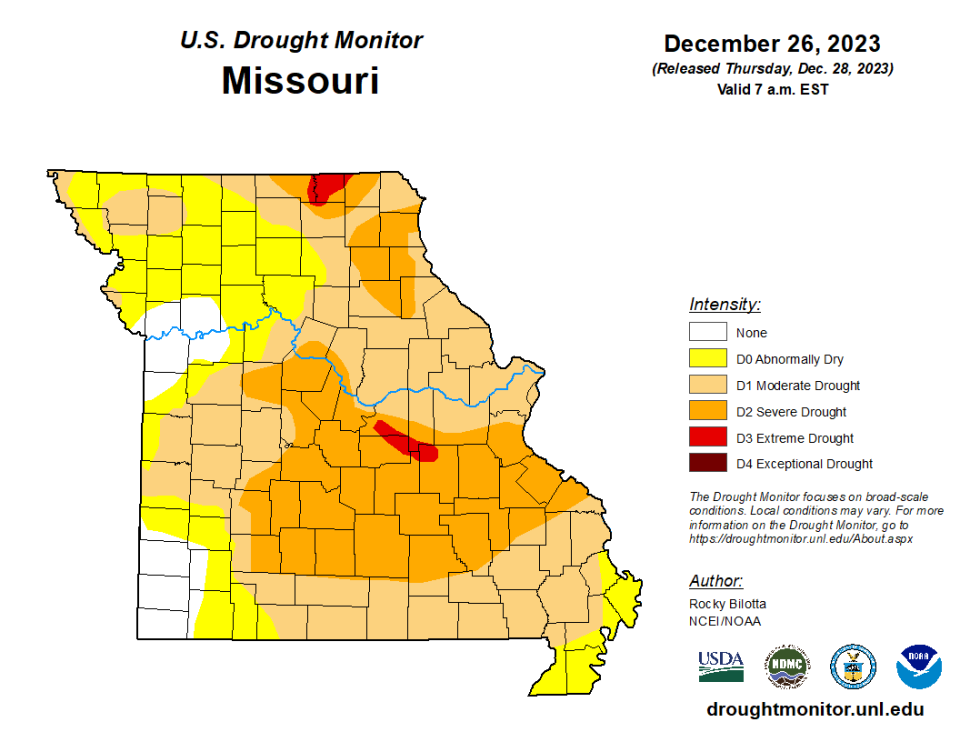Here's why the water level is so low at Springfield-area lakes
If any of your New Year's plans included a visit to a local lake, chances are you noticed it looking shallower. At Fellows, McDaniel and Valley Water Mill lakes, below average water levels can be attributed to an ongoing drought across the Ozarks and Missouri that resulted in one of the driest years on record.
City Utilities manages the lakes for the city's water supply. Joel Alexander, CU's chief spokesperson, said that while the winter season generally brings lower water levels, the lakes' water storage has seen a 5% decrease from the typical average this time of year.
As of Dec. 28, total storage at CU lakes sat at 76.4%, below the 81.8% average, according to the CU website. Fellows Lake is about 10 feet below normal elevation.
"Five percent is not a good feeling, but we're not at an alert stage right now," he said, noting that CU continuously monitors lake levels and can pump more water from Stockton Lake if necessary, as it has been doing for about a month.
Fellows and McDaniel lakes are water sources in Springfield. While CU does not draw water directly from Valley Water Mill Lake, it does flow into Fulbright Spring, which CU uses as a water source. Alexander said Fellows and McDaniel both rely on water from incoming streams and tributaries which in turn rely on precipitation. When these sources are diminished during a drought, so are the lakes.
A city, state in drought
Raychel Nelson, a meteorologist at the National Weather Service, said 2023 was one of the driest years in history for the state, and has worsened in the past month in southwest Missouri. She said the southern parts of the state have not seen as severe of a drought as have the central and northern parts.
"We've been very dry here, and the drought has definitely not let up completely — we've seen some amount of drought for most of the past year," Nelson said.
Springfield is currently experiencing a lower-level drought — rated moderate — but is right on the edge of where drought conditions are classified as severe.

Alexander said the last time Springfield experienced a serious and persistent drought was in 2012, though CU has pumped water into Fellows Lake from Stockton more recently. Nelson noted that for many areas in Southwest Missouri, 2023 placed in the top 20 or top 30 driest years on record, largely due to below normal levels of precipitation.
According to the National Integrated Drought Information System, January through November was the 24th driest in Missouri since 1895, with 2023 seeing the eighth driest November since then.
Droughts are not uncommon in the winter season, particularly as there is less rain during the colder months. Rich Chiles is the project operations manager at the U.S. Army Corps of Engineers Kansas City District, which manages Stockton Lake. He said that while drawdown is expected in the winter, he has not seen it remain low, about five to six feet lower at Stockton, for so long. Boat docks, ramps and marinas have been the most affected during the drought conditions, but recreation has seen no changes at the district's lakes.
Besides affecting water levels, Nelson said droughts are a detriment to agriculture and biodiversity impacting crop yields and wildlife habitats. The risk of fires is also greater during drier conditions.
What's on the horizon?
Nelson said more precipitation is expected within the next one to three months, particularly in the south-most portions of the state. That would improve, if not end, most of the drought in the Springfield area, although the drought is predicted to persist in the rest of the state.
Alexander noted the precipitation is most necessary in northern Springfield as that is where the lakes and water sources are located.
"It just really depends on, especially for us, where the rain lands," he said.
While April showers bring May flowers, Alexander said he is also hopeful spring rains bring improvement to water levels and replenish the lakes ahead of higher water usage seasons, when gardening and lawn irrigation are the biggest contributors to demand.
More: City Utilities looks to expand Stockton Lake water supply stock, secure water beyond 2060
In the meantime, before it rains and pours, Nelson advised people to remain conscious of their water usage and be cautious of starting fires, making sure cigarettes are all the way extinguished and cars are not parked on dry grass.
CU also offers water saving tips, which include taking shorter showers, running washing machines only when full and turning off water while shaving.
Marta Mieze covers local government at the News-Leader. Contact her with tips at mmieze@news-leader.com.
This article originally appeared on Springfield News-Leader: Fellows, McDaniel lakes fall below average water levels amid drought

